|
 BIRTH OF MODERN WELL LOGS
BIRTH OF MODERN WELL LOGS
All the
logs mentioned so far, except the caliper, needed a conductive fluid in the
borehole in order to operate. The induction log was introduced in 1949 to
overcome this requirement in holes drilled with air or oil based drilling mud.
The log was calibrated to read rock conductivity by inducing currents with
electromagnetic coils. Prior to this invention, logging tools impressed currents
into the formation by means of direct application of voltages from the logging
tool electrodes. Over the next ten years, the induction log also became popular
in wells drilled with fresh mud.
 Henry
Doll of Schlumberger developed the induction log from research he
had performed to create the mine detector during World War Two. He
was also responsible for the invention of the microlog, laterolog,
and microlaterolog. Henry
Doll of Schlumberger developed the induction log from research he
had performed to create the mine detector during World War Two. He
was also responsible for the invention of the microlog, laterolog,
and microlaterolog.
Analysis
of water saturation became more reliable because of reduced borehole
effect on the resistivity measurements, compared to conventional
electrical resistivity logs. To some degree, bed boundary effects
were more predictable and compensated for electronically. The
induction log has evolved considerably over its fifty year life
and is the most common log run today.
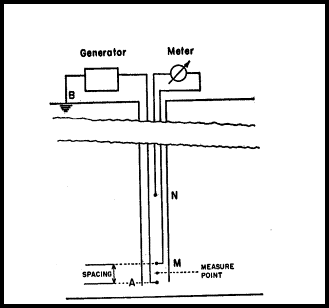
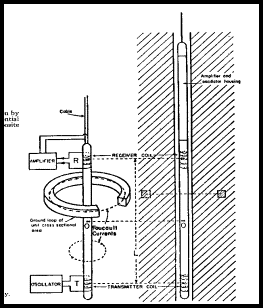
Comparison of Electrical Survey (ES) and Induction
Log (IL)
The
electrical, SP, and gamma ray logs all measured the average value
of rock properties over eighteen inches to five feet of rock thickness.
Beds thinner than this could not be detected or evaluated. The
microlog was introduced in 1948 and allowed resistivity in beds
as thin as two or three inches to be measured at a correspondingly
shallow depth of investigation into the rock. The log can be
thought of as a miniature ES log supported on a rubber pad
pressed tightly to the borehole wall.
The
curve shape approach to analysis was commonly used for microlog
data, although laboratory derived charts allowed quantitative
analysis of formation factor, and as a result, porosity.
The curve shape analysis for micrologs provided rapid visual identification
of zones which were invaded by drilling fluid, and were thus permeable
to some small degree. The log is still used today for this purpose.
Microlog circa
1949. Shaded areas show good SP and "positive separation",
indicating permeable rock. Combined with high resistivity on the ES
log, this combination of logs could pinpoint oil or gas reservoirs.

The
laterolog was also introduced in 1948 - 1949. It was a multi-electrode
electrical log designed to minimize borehole effects in salty
drilling mud. Again, improved resistivity values led to better
water saturation and porosity determinations, still using the
Archie method.
The
microlaterolog, to replace the microlog in salt mud, was first
seen in 1952. Curve-shape analysis was not easy, but standard
Archie methods worked well with this data. Other similar tools,
such as the proximity log, and the micro-spherically focused log,
are variations of the microlaterolog designed to improve shallow
resistivity measurements in a variety of borehole conditions.
Neutron
logs first appeared in 1938, but were not common until l946, when
better sources of neutron radiation became more readily available.
Neutrons emitted by the source, are absorbed by hydrogen atoms,
which are common in water and petroleum. Qualitative analysis
of porosity (which contains water or oil) was possible by detecting
the number of neutrons which were not absorbed but were scattered
back to the detector. In some tools, the captured gamma rays created
by the neutron bombardment were counted instead of the neutrons.
This
was the first independent source of porosity information that
did not rely on Archie's formation factor concept and the resistivity
log data. The tool had, and has, its faults, but modern neutron
logs are useful quantitative analysis aids. Again, better
detectors have increased the resolution and accuracy of the measurements.
The modern version of the neutron log compensates for borehole
size and a number of environment factors automatically.
The
two-receiver acoustic travel time (sonic) log showed up in 1957.
Laboratory work had demonstrated that the travel time of sound
in a rock, after adjustments for fluid and matrix rock travel
time values, was capable of estimating porosity. Thus, another
independent source of porosity data was born.
M.
J. Wyllie published an analysis method for apparent porosity
from the sonic log using the time average equation in 1956. It
is one of the most common analysis methods in use. The laboratory
work and relationships between porosity and sound velocity (or
travel time) was exhaustively studied between 1940 and 1965. Much
of the work was aimed at solving problems in seismic survey
analysis.
Strangely enough, the Wyllie formula, for all its success over
almost fifty years of use in log analysis, can be shown
to be physically incorrect in the laboratory and in theory for
many situations, especially those involving compressible fluids
such as gas.
The
sonic-resistivity crossplot was invented shortly after the sonic
log. It allowed visual as well as quantitative presentation of
porosity and water saturation results on one piece of paper without
the use of additional charts, nomographs, or slide rules (hand
calculators had not yet been invented). It was tedious work, but
thousands of crossplots were made during the sixties, and a few
less progressive analysts still use them today.
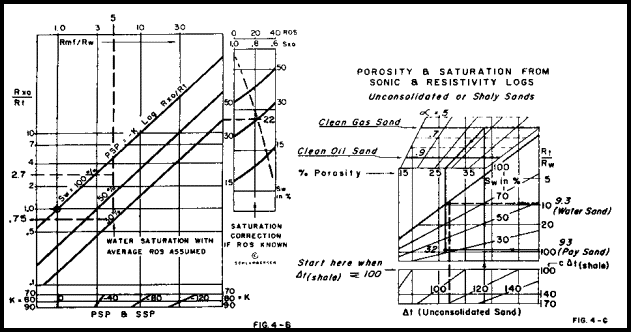
Sonic-Resistivity Crossplot Analysis for Porosity
and Water Saturation
Quick
look methods to differentiate hydrocarbon zones from water zones
also followed the introduction of the sonic log. One such technique,
the "Rwa Method", is still very popular. The principle
used was to quickly calculate, from the Archie water saturation
equation and the sonic log porosity value, the apparent water
resistivity which would make the zone 100% water saturated.
If
a particular value of water resistivity was considerably higher
than the trend of many other values from above and below it in
the borehole, then hydrocarbon could be suspected in the anomalous
zone. No shale corrections were made, so shaly sands often showed
poorly in this analysis.
Another
quick look method is called the overlay method. The simplest approach
was to overlay the resistivity log and the sonic log in such a
way as to have the two curves fall on top of each other in the
obvious water zones. Zones in which the resistivity log fell to
the right of the sonic log were either potential pay zones or
tight (non porous).
The
overlay method was improved by generating compatible scale logs
so that scaling differences did not cause false shows. The compatibility
could be created by transforming the resistivity and sonic curves
to apparent porosity or to apparent formation factor. This was
done at the wellsite by appropriate function formers in the surface
electronics, or back in the office by use of computer processing.
The
invention of the logarithmic presentation for resistivity data,
when the dual induction log was introduced in 1962, made quick
look overlay methods even more popular and practical at the well
site.
Many
modern logs are designed to give good visual impressions of lithology,
porosity, or hydrocarbon by means of compatible scale overlays.
The density-neutron combination log is the most common example.
The latest versions of computerized logging trucks even shade-in
the separation between compatible scaled logs to emphasize the
apparent prospective zones.
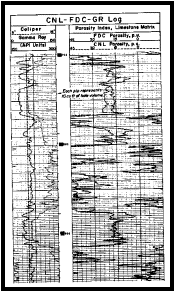 The
density log was introduced in l959. It was another independent
source of porosity data. With three sources of apparent porosity,
(sonic, neutron and density), in addition to the resistivity methods,
it was now possible to account for more variables. This led to
crossplot or chartbook methods which compared the apparent porosity
values from two sources, to help identify lithology (shale content
or limestone - dolomite ratio, for example). The
density log was introduced in l959. It was another independent
source of porosity data. With three sources of apparent porosity,
(sonic, neutron and density), in addition to the resistivity methods,
it was now possible to account for more variables. This led to
crossplot or chartbook methods which compared the apparent porosity
values from two sources, to help identify lithology (shale content
or limestone - dolomite ratio, for example).
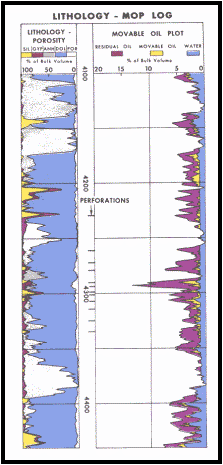 The
sonic-density crossplot was common in the early sixties, with
the density-neutron crossplot becoming more common in the late
sixties, as the neutron logs became better calibrated and scaled
in porosity units. The
sonic-density crossplot was common in the early sixties, with
the density-neutron crossplot becoming more common in the late
sixties, as the neutron logs became better calibrated and scaled
in porosity units.
Since
a crossplot is merely the solution to three simultaneous equations
in three unknowns, the use of computers to solve these equations
was a popular subject in the early sixties. Extensions of this
concept to four, five or six simultaneous equations demanded a
computer since graphical methods could not cope with the multi-dimensional
aspect of the job.
<==
Early Computed Log c. 1966
The desired results from such methods are porosity and the percent
of each matrix rock type present. Usually one extra component
can be found for each additional independent logging tool measurement
used in the simultaneous equations. The method suffered if the
list of unknowns in the equations did not match the real rock
sequence. This can be mitigated, at least in part, by allowing
the computer program to search for the best lithologic model.
Linear
programming (simultaneous equations with constraints) was tried.
It was not very successful, because knowledge of rock properties,
the so-called known data, was not really very well known. As well,
tool response to rock mixtures was not well defined.
The
late fifties and early sixties also saw a great deal of work in
atomic physics and both the pulsed neutron (or atomic activation)
log and natural gamma ray spectroscopy log were described. However,
suitable tools did not become available until 1968, and were not
common until 1971.
The
pulsed neutron log provides another apparent porosity evaluation,
as well as an independent assessment of water saturation. The
logs are also called thermal decay time logs, chlorine logs, carbon/oxygen
logs or spectral gamma ray logs (note the lack of the word "natural"
in this case) depending on the details of the source-detector
systems and the rock properties derived from the data. They are
usually run in cased holes.
The
natural gamma ray spectrolog allows analysis of uranium,
thorium and potassium content in a formation. This is used to
help segregate shale from other naturally radioactive rocks, such
as uranium bearing dolomites or potassium rich sandstones. In
conjunction with other log data, it can help define the types
of clay minerals present in the shales.
The
nuclear-magnetic resonance log was described in 1956. The theory
suggested that effective porosity and permeability could be determined
from the measurements. Good examples of this are still rare even
after nearly fifty years of refinement- but Year 20XX versions
of the tools will probably succeed. Unfortunately, the tool sees
a very small fraction of the rock seen by other logs, so it may
never be realistic to compare values from such dissimilar rock
volumes.
Other
methods for interpreting permeability, based on empirical relationships
between porosity and water saturation had been presented prior
to l960 and are still used today. Some examples are the Timur,
Wyllie-Rose, and Coates-Dumanoir methods.

Sketxh of a logging truck circa 1962,
the year the author began his career in the industry
Prediction
of abnormal pressured zones, and potential drilling or blowout
problems, were developed from the various porosity estimating
logs, beginning in l956. This was based on depth-trend line analysis
of the sonic log primarily, although most logs, including density,
neutron, and resistivity logs can be used.
The
log types and analysis methods discussed so far are all
used in open-hole conditions, that is, after the well is drilled
but before it is cased with pipe and cement, and finally completed
to flow oil or gas (or heaven forbid, water). All the radioactive
logs (gamma ray, spectral gamma ray, neutron, pulsed neutron)
except density logs can be run in cased holes, and interpreted
with approximate corrections for casing size and thickness.
Resistivity
and older style sonic logs cannot be run in casing to obtain information
about the rocks, although the sonic log is used to evaluate the
cement behind the casing. Sonic wavetrain logs run through the
casing are sometimes useful in evaluation of the rocks, but are
most frequently used for cement evaluation. Recent versions of
sonic logs use computer processing of the wavetrains to determine
compressional, shear, and Stoneley wave travel times in both open
and cased-hole situations. Resistivity logging through casing
is also being developed.
Other
logs, such as temperature, flow-meter (spinner surveys), gradiomonometer
(a fancy name for fluid density meter), and noise logs are used
to assist in analysis of the location, amount, and type
of fluid flow in producing or injecting wells. The tools and techniques
have evolved gradually since l952, when the first serious effort
was made to evaluate well performance with logging tools.
While the early years were clearly a period of invention of
hardware and techniques, the middle years could be termed the
period of understanding. Although significant new tools were
developed, such as the sonic and density logs, the
analysis process required more formidable effort.
Customers wanted more reliable answers along with the more
reliable logging tools.
|

